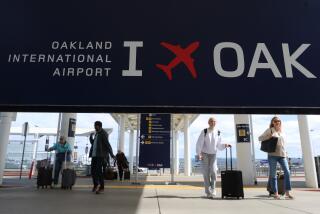Plan Offered to Ease Airport Noise Problem
- Share via
About 1,000 acres of homes and businesses on Point Loma--which has the greatest airport noise problem in California--could be spared from the roar of big jets if the direction of take-offs from Lindbergh Field was changed slightly toward Mission Bay and the airlines were required to phase in quieter jets.
That was the recommendation made Tuesday to the San Diego Unified Port District, the agency that operates the airport, by a consultant hired by the Port District to come up with methods of reducing the noise made by incoming and departing planes.
While the two suggestions by the consultant, CH2M-Hill of Newport Beach, are clear and simple enough, they will have to withstand scrutiny from several sources, including the Federal Aviation Administration, affected homeowners and the 21 airlines that use Lindbergh Field. A Port District hearing on the recommendations has not yet been scheduled, though it will take place sometime this fall.
Over the years, numerous lawsuits have been filed against the airport, particularly by residents of the Loma Portal neighborhood, claiming a loss of property value and interference with private lives. Most recently, 144 property owners in Loma Portal--a section of Point Loma--filed a $39-million lawsuit against the Port District in July.
The airport, which is expected to undergo steady growth over the next 10 years--from nearly 8 million passengers in 1985 to 14 million in 1996, an increase of 75%--is technically in violation of California airport noise standards. But like many other airports in the state, it is operating under a variance granted by the state.
One condition of the variance is that the Port District undertake a study to pinpoint what can be done to reduce noise.
The recommendation that the departure flight path be changed involves Runway 27, which accounts for more than 90% of all takeoffs at Lindbergh Field. Instead of flying straight out over Point Loma or veering slightly north--the two most commonly used flight paths--the consultant recommended a change that would take planes slightly to the north and east.
Rather than flying over houses and businesses, the new flight path, technically called a heading of 310 degrees, would take jets over part of Mission Bay, open space and industrial sites.
What this does to Point Loma is remove about 1,000 acres that are now affected by airplane noise, a reduction of 54%, according to Richard C. Rawlings, a CH2M-Hill spokesman.
The second part of the consultant’s recommendation would require the airlines to phase in new and quieter jets by 1991, when airlines that have more than four daily landings or departures at Lindbergh Field would have to use the quieter planes at least 80% of the time.
“We’re giving them five years, which we feel is more than adequate,” Rawlings said, adding that the airlines can meet the deadline by a combination of buying new planes and mixing the planes in their fleet so that more of the quieter ones are used in San Diego.
Rawlings acknowledged that there are some problems with the recommendations.
By shifting the 1,000 acres away from Point Loma to part of Mission Bay, hotels in the resort area could be affected by noise. In addition, the change in flight paths could lead to backups at Lindbergh Field, particularly during the morning and evening peak periods.
Before any change in the flight path is made, the FAA would have to approve--after requiring an environmental impact report, a time-consuming process.
Rawlings also said that the airlines would have to be satisfied that the change would not substantially hinder their operations or schedules.
Even with the changes, however, by the year 1991, 1,132 acres of residential property on Point Loma would still be affected by noise levels higher than allowed by state regulations.
The noise abatement recommendations presented by the consultant Tuesday are the first of a two-part study. The second part deals with land-use planning under the flight path and finding ways to ameliorate noise, such as soundproofing homes and businesses, buying properties, making zoning changes and the like.
That part of the study is due for completion in December.
More to Read
Sign up for Essential California
The most important California stories and recommendations in your inbox every morning.
You may occasionally receive promotional content from the Los Angeles Times.













